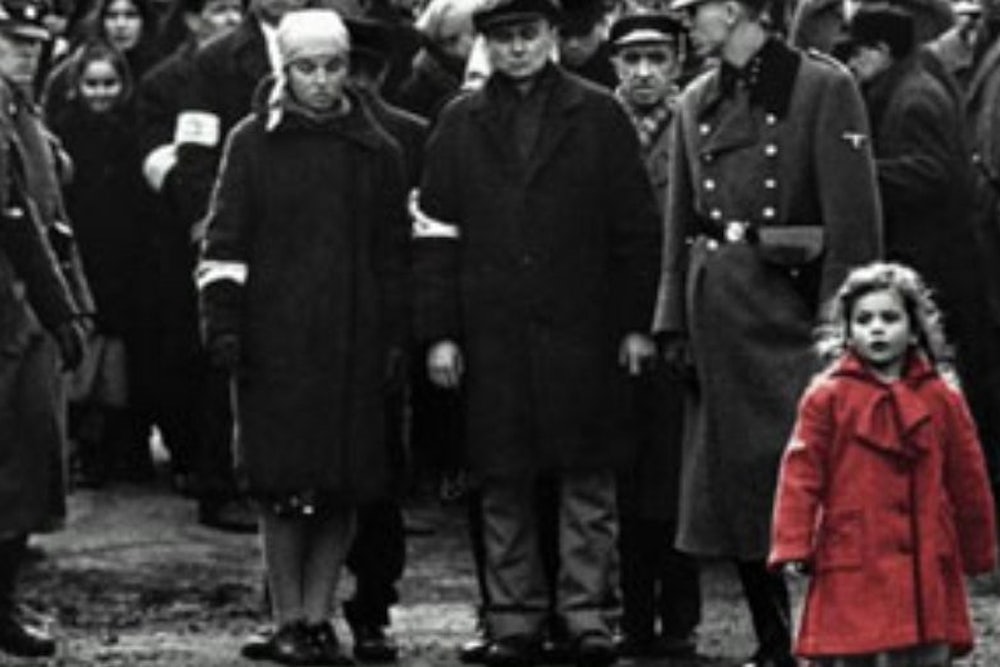Here’s an oddity, from Yahoo Movies this past Monday: two photographs, side by side—a dark-haired woman, apparently 23-years-old, in a belted red raincoat, standing in front of a wall covered with Jewish imagery; and then, a child, 3-years-old, in a red coat, but in the foreground of a black-and-white picture that shows German soldiers guarding abashed citizens. It is the same person in both pictures, Oliwia Dabrowska, from Krakow in Poland. There is a heading to the pictures and the short article that follows: “‘Red coat girl’ from ‘Schindler’s List’: I was ‘horrified.’”
Have you placed it yet? In Steven Spielberg’s Schindler’s List, there is a scene in which Oskar Schindler and his wife, both on horseback, and on a knoll above the city, see one of the first round-ups of Jews by German soldiers. They shot the sequence in Krakow, and it is a very persuasive evocation of Schindler’s mounting distress and conscience. But then something horrifying happens. Schindler notices one little girl, on her own in the crowd, and just in case we haven’t got the point Spielberg colorizes her coat. He makes it a dusty red, so that we will notice it and feel it. As if the true impact of the Holocaust depended on costume. The colorizing is very tastefully done, but that doesn’t stop the device from being appalling.
Not that Dabrowska’s horror was prompted in that way. Spielberg plainly cherishes children, and when they had shot the scene he took Oliwia aside and told her not to look at the finished film until she was much older. Like 18, he thought. But older people talked about the scene and the film, and Oliwia was impatient and frustrated, so at the age of eleven she saw Schindler’s List and she was “horrified”. She felt she never wanted to see the picture again. You can understand her feelings, just as you can appreciate Spielberg’s advice. A child is not ready to see Schindler’s List, which is a candid and vivid look at the experience of holocaust. But a child is not ready at the age of three to be rounded up for extermination. There are things too horrific to be filmed, or too awkward to be digested as part of a drama. Yet we have made a kind of pledge to be faithful to what happened in those places, and not to forget.
But what are we meant to remember? In the same week as the story on Yahoo Movies, it emerged in a years-long research project by the U.S. Holocaust Memorial Museum that we have been living with a moderate idea of the Holocaust. We are all inclined to say “six million’, when the subject arises. It’s a round figure, but that’s the automatic answer to how many people died. Except that the new research says it was far more—try 15-to-20 million. If you think about it, the margin of latitude in the new estimate is nearly the same as the original “knowledge.”
This news is very tricky. I can believe that you were already “horrified” or “chilled” or “stunned’ or “devastated” by six million. Some people killed themselves in dismay when that number was reported or when they had to live with their own grief and guilt. Suppose the true number is three times six million, is it within your capacity to have all those desperate reactions tripled? Surely it can’t be possible to find any useful way of saying 18 million dead was significantly worse than six million, The trickiness here is our vulnerability to a moment in history in which the slaughter is beyond our imaginations. A young person today—and there are plenty who hardly know what the Holocaust was—will pass over the adjustment in numbers as a technicality.
To which, I daresay, Steven Spielberg would respond that that’s why he made Schindler’s List—to help future generations remember—and that’s why he put the little girl in a red coat. It was dramatic; it was personalizing history; it was giving us an aid to memory. One has to acknowledge the legitimacy of that explanation, just as I feel bound to say that Schindler’s List is, for the most part, an extraordinary and moving film. Still, I feel it has the awful vulgarity of the red coat, in the way that Saving Private Ryan has the gross and unnecessary book-ending of the elderly Ryan at the cemetery in Normandy worrying over whether he deserved to be saved. Whereupon, a Spielberg, or any leading director, could say that’s what movies try to do. They make a story out of history. Only recently, there are important ways in which Lincoln, Argo, and Zero Dark Thirty all play movie games with the facts. In all those cases, under criticism, the filmmakers said some license was necessary, and legitimate. Documentary films often make exactly the same defense. It's film itself that is so tricky.
So maybe remembering will depend on the horror of white lies, or adjustments. Or maybe the idea of remembering is simply a vanity. Who remembers what the Black Death was like or the evil of the Inquisition? This is a riddle if you love story and movies; if you respect history, it becomes much more than a riddle. I don’t like the red coat; it gave me a queasy feeling the first time I saw Schindler’s List. And I know that it was in the profound nature of Hollywood that the concentration camp story could only be told in a big, mainstream picture if someone found a story that had at least a touch of the upbeat. That was Oskar Schindler.
There’s something else to remember in the Yahoo Movie story, with its two pictures of a young Polish woman twenty years apart: “Incidentally, Schindler’s List 20th anniversary limited edition DVD/Blu-ray/digital copy/Ultra Violet is available on March 5.”
